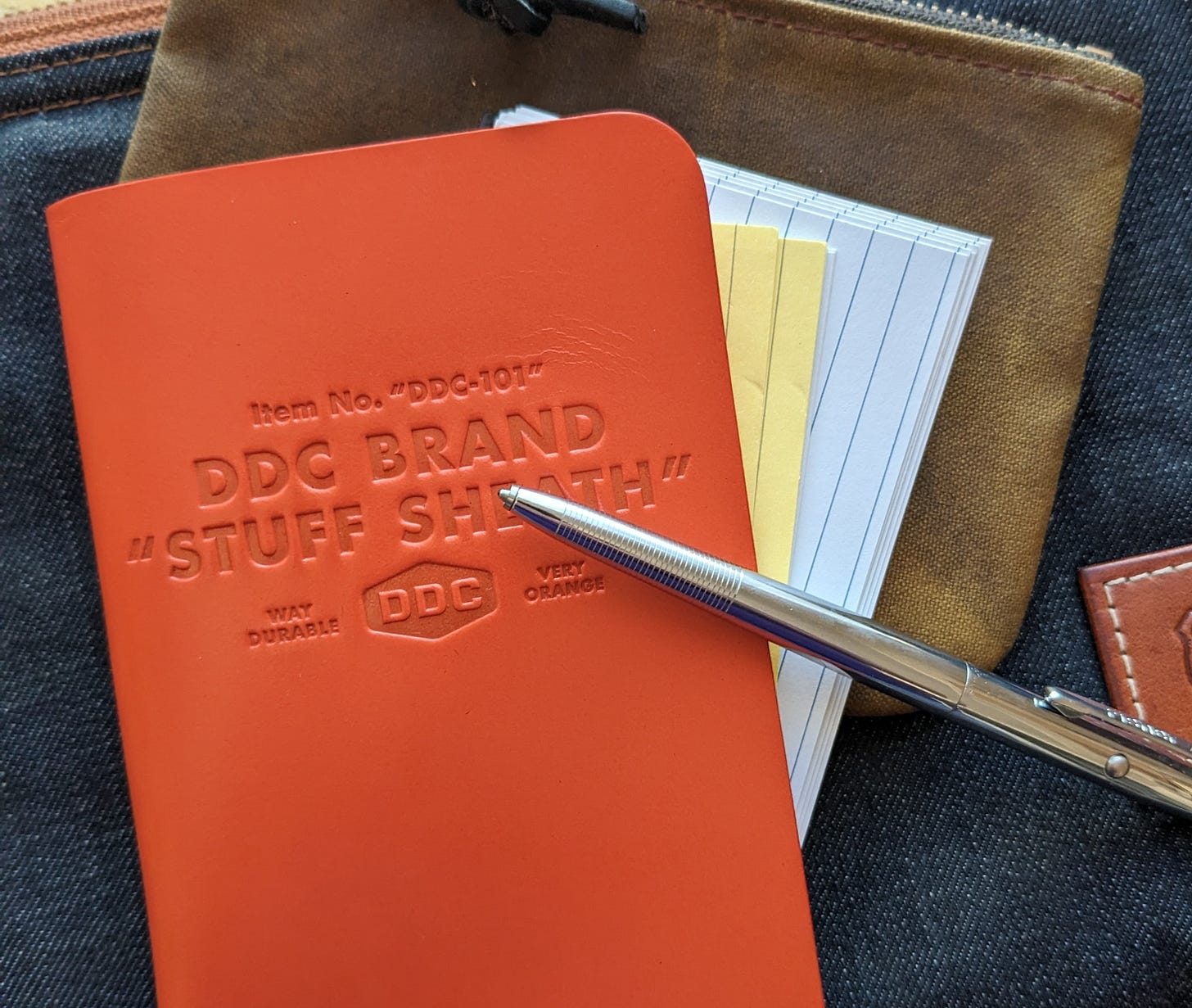Ideas are fleeting.
And this is no less true for Masons.
We might be taking a shower when suddenly an idea for a short Lodge talk comes to mind.
We might be driving when we realize that we should honor a particular Brother for his unique contribution to our Lodge.
We might be sitting at work when the muse strikes, giving us an idea for our article in the upcoming Lodge newsletter.
We might be watching television when we remember that we should send our ill Brother a get well card.
If we don’t do something with those flashes of inspiration, the moment they strike, we will forget them. No matter how hard we try to remember them, repeating them in our head, more often than not, we will forget them.
The fact that we forget all of these things doesn’t mean that we are morons, it simply means that we are human. It’s a tendency that I’ve learned we all suffer from.
My solution is to do my best to always have a good pen and a scrap of paper handy so that I can write these things down the moment inspiration strikes. That’s why you can find something new to read from me just about every day here at Emeth, or at Cameron M. Bailey, or even over at The Keystone. Because I jot the flash down, and am then able to look at it days or months later and craft it into an essay.
But, all of this note taking is far outside of my character. I don’t like taking traditional notes, and I avoided taking formal notes for most of my life. I can’t imagine much worse in the world than running around with a blank book or tablet, taking reams and reams of notes. Well, using a phone to do it instead would be worse I suppose. Much worse.
As a result, I’ve had to come up with my own way of doing it.
And that way centers around 3X5 note cards. So cheap at the office supply store that they are almost free. And in bad weather, Rite in the Rain note cards really come through.
Now I’ve tried little booklets in roughly the same size, I know that a lot of people love those. I’ve used lots of them, Field Notes, Moleskine, Rite in the Rain, the gamut. But, I don’t like the form. A booklet is static, one page after the next. The pages can’t all be laid out and reordered, enabling interesting connections to be found. Note cards can. We can grab a big stack of them, filled with ideas, lay them out, and discover connections between ideas that we never would have realized in any other way.
I’ve got note cards everywhere. In boxes around the house, in my briefcase, indeed there are thirty or forty of them sitting on the table next to me as I write this missive.
That though points out the problem with note cards. Somehow they have to be organized while being worked with.
The easiest way to do this, and what is almost a perfect solution is the humble binder clip. A’ la the Hipster PDA method. Just a dozen or so note cards, held together with a binder clip.
It is close to a perfect solution, but it isn’t quite perfect. The problem is inherent to the binder clip. They are cheaply produced metal, and hence they have sharp corners that will undoubtedly wear a hole in one’s clothing over time.
Other than that one small problem though, the Hipster PDA method is truly great as the cards can be taken out and used one by one, or held together and thumbed through like a booklet, reordered and reorganized at will.
As time has gone on, I have continued to search for a better solution.
For about a year now, I’ve been using a Rite in the Rain Index card wallet. And it has been almost perfect. I’ve got a single exposed card on a good writing surface, a couple more behind it, and a dozen or so stored inside of it.
As cards are written on, they can be moved inside and another blank added to the exterior.
The trouble is, with used cards stored inside, they can’t be thumbed through easily. And that adds friction to my work. I find that I leave them inside the wallet, rather than checking through them as my day goes on, lessening their usefulness.
I also find that I don’t much care for the look and feel of the wallet. Nylon and Velcro, a utilitarian style.
Other versions are made out of leather, such as the Pocket Briefcase. Those look good, and would likely feel good in the hand, but they just don’t hold enough cards for my use. I scribble on these things a lot. A few with good ideas go into a box for long term use, but I use them for just about everything I need to remember, so lots of them are only with me for an hour or two before they get discarded, and the Pocket Briefcase just doesn’t seem to have the capacity I need.
I believe that I have hit on a better solution.
There’s a fellow down in Portland, Oregon named James Draplin, and he makes neat stuff inspired by old stuff. I imagine that he is most known for his creation Field Notes.
One of the many things he has created is what has to be the most simplistic cover for Field Notes imaginable, his DDC Brand Stuff Sheath. It’s simply a little envelope, with two open sides, crafted out of heavy leather.
The idea is that you just stuff your Field Notes booklet into it, along with, to use his words: “Strange Missives, Ephemera, Rescued Artifacts, Questionable Items, Loose Stuff, Weird Documents, Wads of Loot and General Riff Raff.”
The thing is though, it will hold a nice big stack of my index cards, and my Fisher AG7 Space Pen perfectly.
Actually, it’ll hold a heck of a lot more cards than my Rite in the Rain wallet. And for me, that is a very good thing.
So that’s my current system. A big old stack of 3X5 index cards shoved into the Stuff Sheath, along with a very strong pen, all riding in my front pocket when out and about.
Is it perfect?
Only a lot more time with it will tell. But, as of today, it is as close to perfect as I’ve been able to discover.
You can snag your own Stuff Sheath, in eight different colors right here:
I have to believe that the ‘natural’ version would be the most elegant, and would patina nicely, but Mr. Draplin seems to specialize in orange, and who am I to argue with the artist, so for me, orange it is.
None of the links above are affiliate links or sponsored links. We don’t do paid advertising here. Emeth is paid advertising free, supported by its readers, and 100% human written.
If you missed it, on Sunday I posted a Digest of all the great stuff here on Substack. You can check it out at:







If you really like paper that's fine, but using your phone isn't at all "much worse".
I use Google Keep for random notes and reference info, from my prayer list (constantly changing), Temple wifi passwords, to my pant size or what my wife may like for her birthday or Christmas.
I use Google Tasks for things that require action or just a reminder of something to add to some other record later.
I keep longer notes, lists and drafts in Evernote. This, as with notes in Keep, I can share with others as needed.
I have my phone on me at all times, even next to my bed, so when Inspiration strikes, there's no object between me and a note I cannot lose in the wash.
I do not realize this would turn into a note taking implement measuring contest! :)
I was going to abstain out of fear of hurting the luddites out there. The comments demonstrate the seal has been broken! Here goes:
I have been trying to perfect the way to capture those fleeting thoughts, whimsical quips from articles read, helpful ideas in Youtube videos and most importantly meaningful quotes and references from books. This all amounts to a lot of papers, notebooks, cocktail napkins, etc.
What I have implemented is a aggregation of tools. Starting with Obisdian as my second brain, utilizing the Obsidian web clipper app for anything in my browser, scribd for podcasts, Readwise for books and articles. Each of those options connect to Obsidian directly.
Imagine reading a book on your Kindle e-reader and highlighting something meaningful. How about if those notes and highlights end up automagically in your second brain? With Obsidian I can link and tag specific things and visualize their connection to other things I have collected in the past and placed in there. This allows me to learn deeply through a process called syntopical reading.
Then there are those times when I am not able to access my second brain like when I am at work. For this, I use a reMarkable Paper Pro for capturing those tidbits of knowledge. The reMarkable does not directly integrate with my second brain, so I must import those notes manually.
There is not a perfect solution, but with these methods, I am able to capture most of these golden nuggets of knowledge.